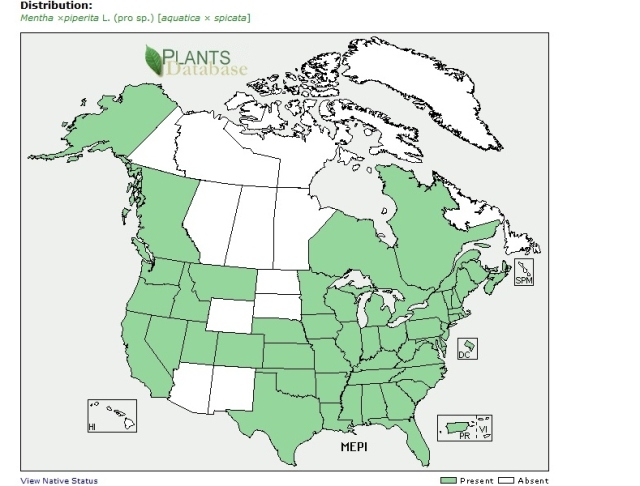Peppermint (Mentha piperita)

General Information:

Peppermint is perennial plant that is found all around the world, and originates from Europe and Asia. It is considered an invasive species in North America, since the conditions that allow it to grow are easily met here (moist, temperate climate). Different varieties of peppermint are also present in South America, Africa, and Australia. Peppermint blooms in the mid-springtime and is usually harvested around July/August.
 Peppermint is easily identified by its distinct scent. When the flowers bloom, they produce small, purple buds, and the leaves are a dark shade of green and very shiny, with little fringes that point away from the stem. Since peppermint is a sterile hybrid between spearmint and watermint, they do not produce seeds. Since they cannot produce seeds to reproduce, they spread out their rhizome horizontally and propagate.
Peppermint is easily identified by its distinct scent. When the flowers bloom, they produce small, purple buds, and the leaves are a dark shade of green and very shiny, with little fringes that point away from the stem. Since peppermint is a sterile hybrid between spearmint and watermint, they do not produce seeds. Since they cannot produce seeds to reproduce, they spread out their rhizome horizontally and propagate.

Traditional Uses:
Peppermint has been used by a variety of civilizations for thousands of years. Egyptian pharaohs were buried with peppermint leaves, and cities in Rome used peppermint as a decorative plant, and lined their public sidewalks and gathering places. Peppermint was first documented as a medicinal plant in London in 1721, where it was thought as a remedy that cured sore, venereal diseases, headaches and colds. Excessive doses of peppermint oil can be toxic.
In terms of medicinal use, peppermint has been used to treat a wide variety of health conditions. The chemicals in peppermint have a calming, soothing effect on humans, and has been traditionally used to treat indigestion, nausea and diarrhea. People collected the oil from these plants, which are high in menthol and methyl salicylate, which have calming effects on the digestive system.
The traditional routes of ingestion of peppermint oil have been drying the leaves and making them into tea or creating a tincture that can be drank. More recently delivery system have been capsules, which can dissolve periodically in the stomach to slowly release its contents.
The chemicals that exist in Peppermint that give it medicinal properties include methanol and menthyl acetate, which have shown to have counterirritant qualities.
Peppermints are also commonly given out as an after dinner mint, where it can cover up bad breath as well as aid in digestion.
Current Research:
The most notable current research on peppermint is its role as an antispasmodic in the digestion system, and is being tested as a pill to treat Irritable Bowl Syndrome. Enteric-coated capsules are being used so that the pills are not dissolved in the stomach, since peppermint oil can cause heartburn and indigestion if released there.
Another study is testing the effects of peppermint on IBS and comparing it to other treatments such as Fibre and other antispasmodics, and has concluded that peppermint oil was an effective treatment
Besides being tested as an aid to IBS, there is little other research currently being done with peppermint oil.
Sources:
- (http://umm.edu/health/medical/altmed/herb/peppermint)
- Cappello G, Spezzaferro M, Grossi L, Manzoli L, Marzio L. Peppermint oil (Mintoil) in the treatment of irritable bowel syndrome: a prospective double blind placebo-controlled randomized trial. Dig Liver Dis. 2007;39:530-6.
- (http://peppermint.indepthinfo.com/history-of-peppermint)
- https://nccih.nih.gov/health/peppermintoil
- http://www.encyclopedia.com/plants-and-animals/plants/plants/peppermint
- Ford, Alexander C., et al. “Effect of fibre, antispasmodics, and peppermint oil in the treatment of irritable bowel syndrome: systematic review and meta-analysis.” Bmj 337 (2008): a2313.
Page created by Jack Madden
